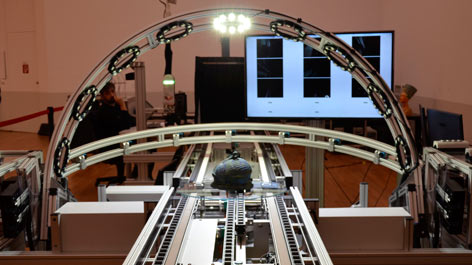Bereichsnavigation
Digitizing and Documenting
Digitization is a key aspect of conservation work in all the Foundation's institutions. It not only allows a digital representation to be studied in place of the original item, but also makes the collections globally accessible.
Digitization as a Conservation Technology of the Future
The extensive measures and projects for digitization in all of the foundation's institutions also contribute to the protection of cultural heritage: Vulnerable objects can be examined via their digital scans; the originals are handled only in exceptional cases.
Microfilms are also still produced. Archived material has been filmed and stored in this way since 1961. It allows the cheap and effective long-term storage of archival documents and a continuity that is unaffected by changes in technology. The Geheime Staatsarchiv Preussischer Kulturbesitz (Prussian Secret State Archives) therefore produces microfilm images, which are stored, according to the Hague Convention for the Protection of Cultural Property, in a disused mine called the Barbarastollen, near Oberried in the Black Forest.
It is digitization, however, that is the technology of the future for conserving collections. The number of accessible digital 2D and 3D-representations of cultural artifacts is steadily growing. This also opens up new perspectives for basic research.
Digital Documentation of Collections
The Foundation is continually increasing the digital documentation of its collections through a number of projects. It has drawn up a digitization strategy that sets out the priorities in terms of content.
If the digitized artifacts are to be of use to science, it is essential to make them accessible. The digitized material and the associated metadata are entered in databases. Online platforms such as SPK Digital allow them to be accessed from around the world. Interlinked databases make it possible to conduct extensive research into the contexts of cultural goods.
Digital documentation is, moreover, an important basis for the restoration of destroyed cultural heritage. It enables archaeological sites, for example, to be reconstructed. Digital object databases can document cultural property that is threatened by illegal excavations and trafficking.
Cooperation on Further Technical Development
The Foundation is committed to the further development of technologies, processes, and standards of digitization as a whole. In particular, rapid progress is currently being made on processes for the three-dimensional recording of cultural artifacts that have a wide variety of surface structures.
One example of an optimized and economic 3D-reproduction technology is the digitization pipeline. This can scan cultural heritage artifacts in just a few minutes and convert the data into accurate digital models. The "CultLab3D" modular scanning pipeline is around seven meters long. A trial run of the system in a museum context was presented publicly in November 2014. The Fraunhofer IGD developed the scanning pipeline together with the Staatliche Museen zu Berlin (National Museums in Berlin) and the Liebieghaus in Frankfurt. The project receives funding from the Federal Ministry for Economic Affairs and Energy.
The Foundation is involved in many other joint projects, with the aims of optimizing new methods in accordance with its own requirements and of making them usable for other institutions.


